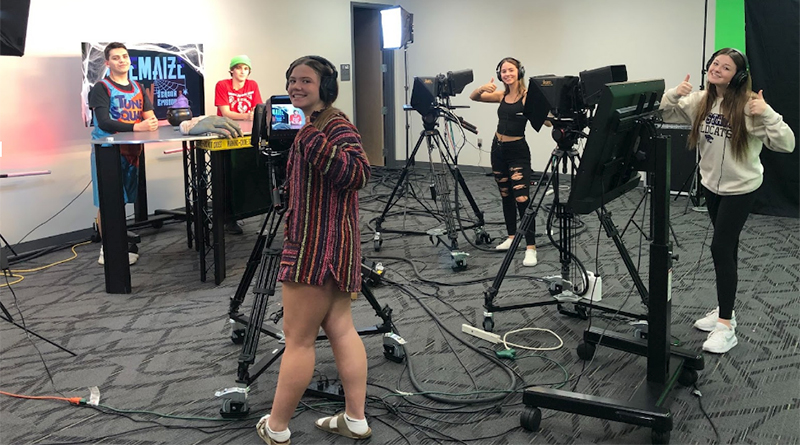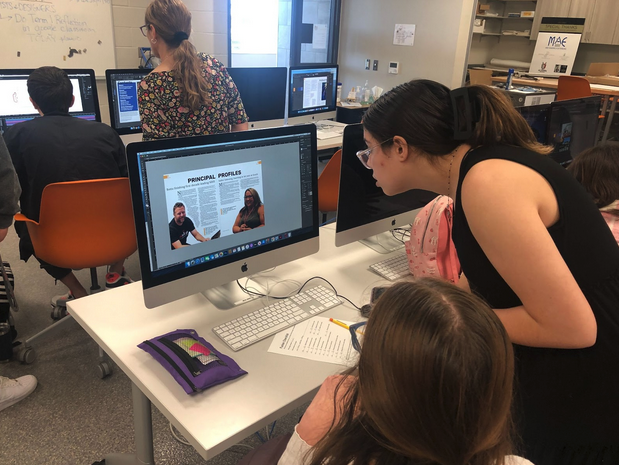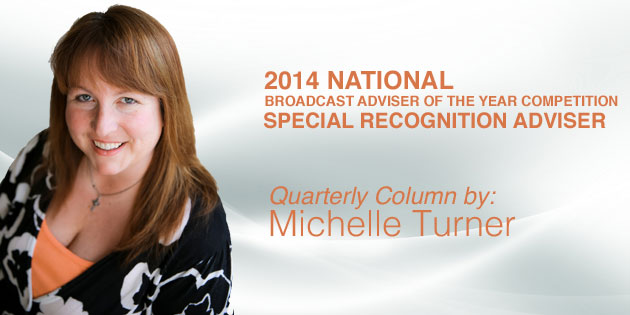4 months of school, 3 different teachers, 2 separate schools, and 1 converged group of high school journalists

There’s no question that the pandemic has drastically changed everything about the way your student media program operates in your school.
From decreased advertising revenue to reduced staff numbers, lack of experience in software creation tools to retraining journalism staffers to push the extra mile on storytelling, many of our programs received several structural blows to the way we operate and create content.
Around a year ago, advisers in the USD 266 district met to address the weaknesses in our CTE class structure, courses we offered and respective student media operations. This conversation consisted of a newsmagazine/yearbook/photo focused adviser, a seasoned graphic design veteran who had zero experience advising student media and another adviser who spent a majority of their time coaching video and broadcasting students.
What if we reimagined the way we produced content for our community? What if we laid everything out on the table and were honest about the negatives of our programs and the places we needed to improve? What if we were honest about decreasing student numbers, inappropriate nesting of classes and started to find solutions as a cohesive group?
How could WE put all of our skills, abilities, experience and programs goals together to embrace the idea of Converged Media? How could we bring together students with different personalities, abilities and intro classes to work as one unified group producing content for two schools (each with 1,000+) students) along with our community?
Here’s the good, the bad, the ugly and the improving parts of our big Converged Media plan in Maize, Kansas, over the first four months of the school year. We hope you can steal some slices of our success, avoid some of our speed bumps and assess how you could work with another teacher/adviser in your own school to better your own program.
Buckle up-we’ll give it to you straight!
Spencer O’Daniel, MJE
Broadcasting/Video adviser
Positives-So far, we’ve been able to pump out 5-10 pieces of content weekly on our website, www.maizenews.com. This includes stories, photo galleries, news and feature video packages, (3) full episodes of our television show and other miscellaneous print stories. Last month, this translated to over 17,000 views of our content between the website, Vimeo, Instagram, Twitter and Facebook. The population of Maize, Kansas, is right around 5,000, so we’re ecstatic about these early numbers. I’ve seen a few amazing conversations happening between writer to designer, designer to videographer, videographer to writer where students are really getting creative with the variety of ways you can cover one topic together through our different publications. Just four months into our converged media experiment, we’ve had students win several state and national awards including a photo of the year honorable mention and Broadcast Journalist of the Year winner. Our group of three advisers does a great job of discussing what’s happening now while always trying to plan 2-4 weeks in advance regarding our deadlines, workflow, how our students work together and even ways we release content on social media and to our community. 90% of the time, the creative energy is high and our students feel real purpose learning how to work together in new ways. Because we are one centralized group covering two different high schools and our community doesn’t have an individual town newspaper, we have bundled our advertising efforts and have had a fantastic fall raising funds for our OneMaize Media group.
Negatives-So far, there just hasn’t been enough time for the three advisers (we don’t all have the same planning period) to comb through the vast amount of details it takes to make sure all of our publications and platforms (print newsmagazine, website, social media, stand-alone videos and broadcast show) are crafted at award-winning levels. We (along with others) are seeing some journalism developmental gaps in our student’s writing skills and we struggle sometimes to show students “how” to be creative. From the broadcast/video side of the equation, I have always struggled on how to get my students more into the “news” side of broadcasting and storytelling, and sometimes it’s been like pulling teeth trying to show a team HOW a broadcast news package is an important part of any great high school show. Many of my videographers have been with me anywhere from 2-4 semesters, so they are also a “work in progress” on understanding how they can craft content together with newsmag writers or the designers in the class. One thing I hope to improve in the spring is trying to get my videographers to create stand-alone website videos at the same quality/level that they are creating content for our monthly OneMaize broadcast show. Our biggest improvement focus within the next couple of months is teaching a veteran video staff new tricks and to work with the other skilled writers, designers and photographers in the program.
Areas of growth over four months-The biggest area of growth would be our workflow, systems and how we do things as a class. We use a different adviser to start each class and we each have our assigned day to start class with announcements on upcoming events, contest recognition, mini-lessons or team building activities. I’ve noticed tremendous improvement from our graphic designers who are learning how to create infographics/photo illustrations and other design ideas without the help of writers/photographers/videographers that can be used on the website. The relationships in the room are really growing and one of my favorite things I’ve seen is when video students talk to the graphic design adviser, newsmag kids stop to ask me about something or when our newsmag adviser (Dan Loving) will take time to watch a feature video package and give a tip or two for improvement. Our students are being more receptive by the month on taking constructive criticism from a different adviser in the room, and it feels like we are beginning to hold each other more accountable to do the little things right as we go along. I’ve always been a huge “culture” guy as part of my journalism program, and I’m seeing more buy-in as students are starting to see the BIG picture as to how being involved with student media can help beyond high school. This includes recruitment/retention of current staff to ensure we continue to IMPROVE next semester and avoid being stagnant in program progression.
Dan Loving
Newsmagazine/Online adviser
Positives- The buzz in the room is amazing. When you’re able to get so many kids together, with advisers who have different areas of expertise, it opens up a bunch of possibilities for learning new skills. If it’s an area I’m weak in, one of my co-advisers might be strong and vice versa. And in areas where we might be deficient, there are any number of students who have perfected or are in the process of perfecting a skill. It’s quite refreshing. I think eventually, this will become an even greater positive. Additionally, having so many kids in the room creates greater diversity in our staff in not only skills and knowledge but also interests. That’s definitely a plus. On a personal level, being in the class with two other pros gives me a different insight into teaching methods. I think over the course of our careers, the opportunity to observe other teachers is limited. We generally are stuck in our rooms without the ability to observe others. That’s even more the case with journalism teachers, who are often the only ones in our buildings who teach what we teach. However, I now have two other people who I can feed off every day, and I think in the long run that will help me become better at my job.
Negatives-There is a lot going on all the time. And while that’s the overall goal, it certainly creates challenges. We have kids coming and going all the time, whether it’s between rooms or going off campus to work on stories. Organization has never been my strong suit, and this is challenging that. This class, while it has been a long-range goal of mine for years, came together very quickly. We didn’t really have the necessary time to create processes that would make things run more smoothly. I think if I had to do it over again, we would start more slowly and spend a more concentrated effort training students.
Areas of growth over four months- One long-range goal is to get the students working more closely together and cross-training them in different skills. Even though we meet together daily, students still tend to be most often split into their different groups based on the competencies they arrived with. In other words, print reporters are still print reporters and broadcast reporters are still broadcast reporters. We will be at our best when students are given the opportunity — and take advantage of the opportunity — to build on different aspects of journalism that they maybe don’t even know they’ll be great at. Additionally, we will need to continue to work on how we do what we do. I’ve said repeatedly to my co-advisers that this is a process. We’re off to a good start and shouldn’t lose sight of that. However, I think we can continue to be better as we tweak things here and there.

Senior editor Isabelle Blasdel looks over a feature spread on both principals in our USD 266 district newsmagazine, Fusion. Collaborating and mixing school content with community coverage throughout your newsmagazine can bring a variety of people to pick up your print publication that maybe weren’t interested before. How can you gameplan your coverage so that each reader can find at least two to three stories to connect with? How can you create content for your news website that’s different/unique but supplements your initial print coverage?
Jodee Johnson
Graphic Design adviser
Positives-The most obvious positive for my graphic design students is that they are creating for the real world. Despite teaching how to design for a target audience, using design briefs, and having the occasional “real” client, the students are getting the best experience in “real life” designing. Additionally, the stakes are raised because peers, parents, and other teachers will see the things they have created when they visit our website or pick up our newsmag.
Another advantage of the class is that my students get to collaborate with their peers. Nothing fulfills a CTE Competency on collaboration like students from two different schools, working together to achieve a common goal. On a personal / professional level, having spent the last 23 years creating my own curriculum and generally staying within the four walls of my classroom, this has been a challenge worth taking on. I am an art teacher; so, learning about the ins and outs of journalism has been a steep learning curve but has definitely helped alleviate my boredom. Additionally, I am learning teaching strategies and classroom management styles from my co-teachers that have also helped revitalize my teaching.
Negatives-As with anything new, it’s a constant learning process. We didn’t really know what we were getting into in August. For example, it seems that we all expected a little higher level of skill in our students that just isn’t there. This being a Capstone CTE class, prior experience is required just to be in the class. However, it seems the Covid learning gap that has been noted in core areas definitely extends to our elective courses. We failed to address that gap in August; but, it will definitely be addressed in January.
I hate to use the word “sacrifice” because it seems so dramatic; but, there also has to be some sacrifices. I gave up my Advanced Graphic Design course in order to shift those students into the new course. Additionally, there is always the component of differing teaching styles being melded together into one class, which as I noted above, is also a positive. Adapting to co-teachers and the give and take required of that could be stressful for some teachers.
Areas of growth over four months-Our second newsmag is coming out in the next week and I know it will be way better than our first! The new buzz in the room when the students are working together is also priceless. And, of course, I have learned a lot about journalism.



